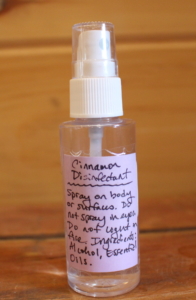Marjoram! Eucalyptus! Cinnamon leaf! Grapefruit! These are some of the aromas coming from small disinfectant spray bottles peppered about in our personal bags and vehicles here at the farm.
Though we have a high level of self-sufficiency and food security here at the farm, there are still times that require us “to go out into the world.” Whether it’s picking up whey from a local  cheesemaker or picking up brew grains from a local brewery to give to the pigs, we ensure our trips off the farm are conducted in a mindful manner. Having a disinfectant spray bottle to use in our vehicles and on our hands is absolutely necessary on these outings when washing our hands with soap and water isn’t readily accessible.
cheesemaker or picking up brew grains from a local brewery to give to the pigs, we ensure our trips off the farm are conducted in a mindful manner. Having a disinfectant spray bottle to use in our vehicles and on our hands is absolutely necessary on these outings when washing our hands with soap and water isn’t readily accessible.
According to the Center for Disease Control (CDC), current evidence suggests that the coronavirus may remain viable for hours to days on surfaces made from a variety of materials. So, to protect ourselves and our community at RTB, we have been making disinfectant sprays!
Watch a quick video of how we make RTB Disinfectant Sprays! CLICK HERE
Note that the CDC guidelines dictate that final alcohol solutions between 60 – 95% will disinfectant (i.e. kill germs) and are effective for use against the coronavirus. Most vodkas and spirits are 80 proof (40%) and therefore do not contain the appropriate alcohol percentage required for disinfection.
Necessary Materials
Alcohol
Choices of alcohol to use:
- Ethanol/Ethyl Alcohol
Everclear, at 190 proof (95% alcohol), can be diluted with water, or mixed with lower percentage spirits, to obtain a final solution adequate for disinfection (>60% alcohol). 60-85% ethanol has the greatest antimicrobial effectiveness.
- Isopropyl alcohol (IPA) / Rubbing Alcohol
IPA typically comes in 70%, 91%, or 99% alcohol solutions. Either can be used to make this disinfectant spray. The 70% solution should just be used on its own, while the 91% and 99% solutions should be diluted with water (to achieve 60-80% alcohol solution for greatest effectiveness).
Empty Spray Bottles
- Bottle size depends on your intended use: smaller ones for personal use, on-the-go, to keep in your car, personal bag, etc; larger spray bottles for disinfecting home surfaces.
- Spray nozzle matters: choose nozzles that produce a mist (rather than a concentrated stream). Smaller droplets mean more surface area coverage with each spray.
- Re-use old bottles, if possible! Glass or plastic is ok.
Essential Oils
- Essential oils are used to cover up the “alcohol-forward” smell of the spray, so any scent will work. However, some essential oils are known to have antiviral properties and might be preferred for this reason. However, it should be noted that the disinfecting power of this spray comes from the concentrated alcohol and is not contingent on any antiviral properties of the chosen essential oil.
- According to an article in the American Journal of Essential Oils and Natural Products, cinnamon, eucalyptus, bergamot, and thyme essential oils have been shown to have antiviral activity. Tea Tree Oil, Kumquat, Lemon Balm, Oregano, Star Anise, Peppermint, Ginger, and Manuka, are additional essential oils with antiviral properties.
Measuring Cup
For measuring the volume of alcohol and water to mix together
Funnel
Choose appropriate size dependent on bottle size
Paper, Pen, and Tape
for making labels
How to Make
- Test to make sure the spray nozzles work on your bottles!
- If necessary, figure out how much water and alcohol need to be mixed together to obtain your desired volume and alcohol percentage for the spray. Several brewery and distillery websites have online calculators that you can use to figure this out, such as this one: https://darkrockbrewing.co.uk/calculators
Use a measuring cup to measure the amount of alcohol and water. Mix together to yield a final solution between 60% – 95% alcohol.
- Use a funnel to pour the alcohol solution into the bottle. Add essential oil drops until desired strength of scent. At RTB, we use about 10 drops of essential oils in our 3 oz. spray bottles of 70% alcohol solution.
- Label the contents of the bottles (alcohol, essential oils) and indicate flammability!
How to Use
Use on hands or surfaces. Note that higher alcohol percentage solutions will evaporate more quickly. Longer surface contact times (the time the surface remains wet) will likely help with the effectiveness of the disinfecting action! Several EPA-registered products that contain ethanol as their primary active ingredient claim to have “contact times” ranging from 30 seconds to 10 minutes.
The disinfectant spray is shelf-stable and will maintain its potency as long as it is kept in an enclosed container or spray bottle. The spray could lose effectiveness if kept uncovered for long periods of time, as the alcohol will evaporate at a faster rate than the water, leading to a more dilute solution.



